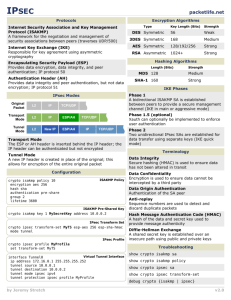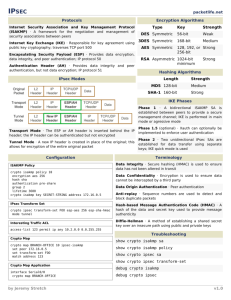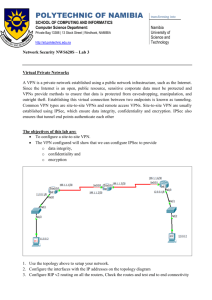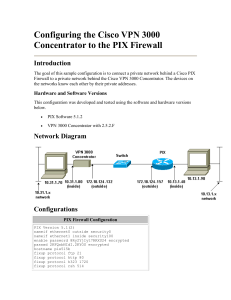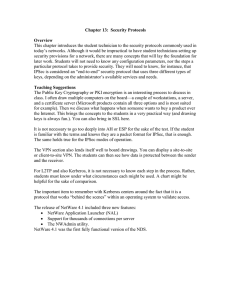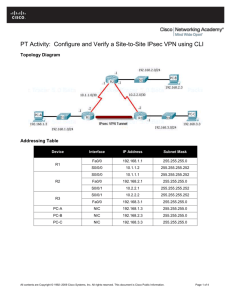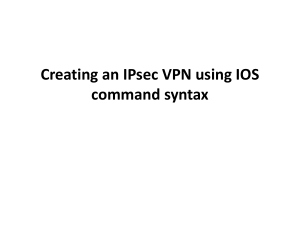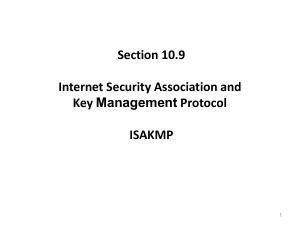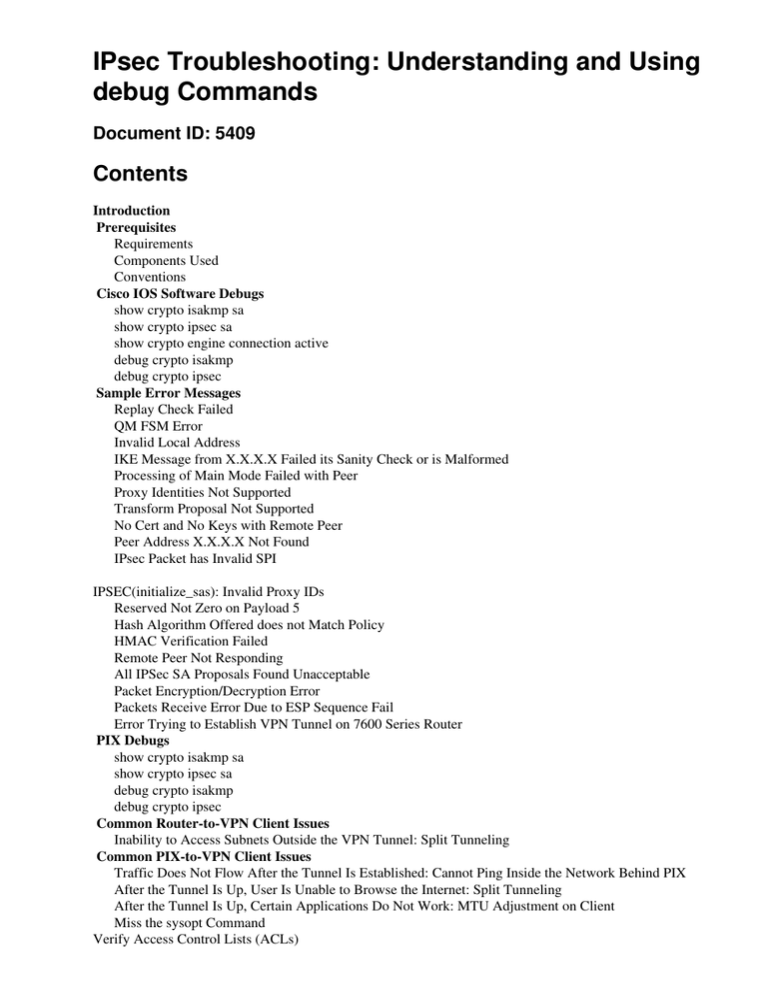
IPsec Troubleshooting: Understanding and Using
debug Commands
Document ID: 5409
Contents
Introduction
Prerequisites
Requirements
Components Used
Conventions
Cisco IOS Software Debugs
show crypto isakmp sa
show crypto ipsec sa
show crypto engine connection active
debug crypto isakmp
debug crypto ipsec
Sample Error Messages
Replay Check Failed
QM FSM Error
Invalid Local Address
IKE Message from X.X.X.X Failed its Sanity Check or is Malformed
Processing of Main Mode Failed with Peer
Proxy Identities Not Supported
Transform Proposal Not Supported
No Cert and No Keys with Remote Peer
Peer Address X.X.X.X Not Found
IPsec Packet has Invalid SPI
IPSEC(initialize_sas): Invalid Proxy IDs
Reserved Not Zero on Payload 5
Hash Algorithm Offered does not Match Policy
HMAC Verification Failed
Remote Peer Not Responding
All IPSec SA Proposals Found Unacceptable
Packet Encryption/Decryption Error
Packets Receive Error Due to ESP Sequence Fail
Error Trying to Establish VPN Tunnel on 7600 Series Router
PIX Debugs
show crypto isakmp sa
show crypto ipsec sa
debug crypto isakmp
debug crypto ipsec
Common Router-to-VPN Client Issues
Inability to Access Subnets Outside the VPN Tunnel: Split Tunneling
Common PIX-to-VPN Client Issues
Traffic Does Not Flow After the Tunnel Is Established: Cannot Ping Inside the Network Behind PIX
After the Tunnel Is Up, User Is Unable to Browse the Internet: Split Tunneling
After the Tunnel Is Up, Certain Applications Do Not Work: MTU Adjustment on Client
Miss the sysopt Command
Verify Access Control Lists (ACLs)
Related Information
Introduction
This document describes common debug commands used to troubleshoot IPsec issues on both the Cisco IOS®
Software and PIX/ASA. This document assumes you have configured IPsec. Refer to Common IPsec Error
Messages and Common IPsec Issues for more details.
Refer to Most Common L2L and Remote Access IPsec VPN Troubleshooting Solutions for information on
the most common solutions to IPsec VPN problems. It contains a checklist of common procedures that you
might try before you begin to troubleshoot a connection and call Cisco Technical Support.
Prerequisites
Requirements
There are no specific requirements for this document.
Components Used
The information in this document is based on these software and hardware versions:
• Cisco IOS Software
♦ IPsec feature set.
♦ 56i—Indicates single Data Encryption Standard (DES) feature (on Cisco IOS Software
Release 11.2 and later).
♦ k2—Indicates triple DES feature (on Cisco IOS Software Release 12.0 and later). Triple DES
is available on the Cisco 2600 series and later.
• PIX—V5.0 and later, which requires a single or triple DES license key in order to activate.
The information in this document was created from the devices in a specific lab environment. All of the
devices used in this document started with a cleared (default) configuration. If your network is live, make sure
that you understand the potential impact of any command.
Conventions
Refer to Cisco Technical Tips Conventions for more information on document conventions.
Cisco IOS Software Debugs
The topics in this section describe the Cisco IOS Software debug commands. Refer to Common IPsec Error
Messages and Common IPsec Issues for more details.
show crypto isakmp sa
This command shows the Internet Security Association Management Protocol (ISAKMP) security
associations (SAs) built between peers.
dst
12.1.1.2
src
12.1.1.1
state
QM_IDLE
conn-id
1
slot
0
show crypto ipsec sa
This command shows IPsec SAs built between peers. The encrypted tunnel is built between 12.1.1.1 and
12.1.1.2 for traffic that goes between networks 20.1.1.0 and 10.1.1.0. You can see the two Encapsulating
Security Payload (ESP) SAs built inbound and outbound. Authentication Header (AH) is not used since there
are no AH SAs.
This output shows an example of the show crypto ipsec sa command.
interface: FastEthernet0
Crypto map tag: test, local addr. 12.1.1.1
local ident (addr/mask/prot/port): (20.1.1.0/255.255.255.0/0/0)
remote ident (addr/mask/prot/port): (10.1.1.0/255.255.255.0/0/0)
current_peer: 12.1.1.2
PERMIT, flags={origin_is_acl,}
#pkts encaps: 7767918, #pkts encrypt: 7767918, #pkts digest 7767918
#pkts decaps: 7760382, #pkts decrypt: 7760382, #pkts verify 7760382
#pkts compressed: 0, #pkts decompressed: 0
#pkts not compressed: 0, #pkts compr. failed: 0,
#pkts decompress failed: 0, #send errors 1, #recv errors 0
local crypto endpt.: 12.1.1.1, remote crypto endpt.: 12.1.1.2
path mtu 1500, media mtu 1500
current outbound spi: 3D3
inbound esp sas:
spi: 0x136A010F(325714191)
transform: esp-3des esp-md5-hmac ,
in use settings ={Tunnel, }
slot: 0, conn id: 3442, flow_id: 1443, crypto map: test
sa timing: remaining key lifetime (k/sec): (4608000/52)
IV size: 8 bytes
replay detection support: Y
inbound ah sas:
inbound pcp sas:
inbound pcp sas:
outbound esp sas:
spi: 0x3D3(979)
transform: esp-3des esp-md5-hmac ,
in use settings ={Tunnel, }
slot: 0, conn id: 3443, flow_id: 1444, crypto map: test
sa timing: remaining key lifetime (k/sec): (4608000/52)
IV size: 8 bytes
replay detection support: Y
outbound ah sas:
outbound pcp sas:
show crypto engine connection active
This command shows each phase 2 SA built and the amount of traffic sent. Since phase 2 (security
associations) SAs are unidirectional, each SA shows traffic in only one direction (encryptions are outbound,
decryptions are inbound).
debug crypto isakmp
This output shows an example of the debug crypto isakmp command.
processing SA payload. message ID = 0
Checking ISAKMP transform against priority 1 policy
encryption DES-CBC
hash SHA
default group 2
auth pre-share
life type in seconds
life duration (basic) of 240
atts are acceptable. Next payload is 0
processing KE payload. message ID = 0
processing NONCE payload. message ID = 0
processing ID payload. message ID = 0
SKEYID state generated
processing HASH payload. message ID = 0
SA has been authenticated
processing SA payload. message ID = 800032287
debug crypto ipsec
This command shows the source and destination of IPsec tunnel endpoints. Src_proxy and dest_proxy are the
client subnets. Two "sa created" messages appear with one in each direction. (Four messages appear if you
perform ESP and AH.)
This output shows an example of the debug crypto ipsec command.
Checking IPSec proposal 1transform 1, ESP_DES
attributes in transform:
encaps is 1
SA life type in seconds
SA life duration (basic) of 3600
SA life type in kilobytes
SA life duration (VPI) of 0x0 0x46 0x50 0x0
HMAC algorithm is SHA
atts are acceptable.
Invalid attribute combinations between peers will show up as "atts
not acceptable".
IPSEC(validate_proposal_request): proposal part #2,
(key eng. msg.) dest= 12.1.1.2, SRC= 12.1.1.1,
dest_proxy= 10.1.1.0/0.0.0.0/0/0,
src_proxy= 20.1.1.0/0.0.0.16/0/0,
protocol= ESP, transform= esp-des esp-sha-hmac
lifedur= 0s and 0kb,
spi= 0x0(0), conn_id= 0, keysize= 0, flags= 0x4
IPSEC(key_engine): got a queue event...
IPSEC(spi_response): getting spi 203563166 for SA
from 12.1.1.2 to 12.1.1.1 for prot 2
IPSEC(spi_response): getting spi 194838793 for SA
from 12.1.1.2 to 12.1.1.1 for prot 3
IPSEC(key_engine): got a queue event...
IPSEC(initialize_sas): ,
(key eng. msg.) dest= 12.1.1.2, SRC= 12.1.1.1,
dest_proxy= 10.1.1.0/255.255.255.0/0/0,
src_proxy= 20.1.1.0/255.255.255.0/0/0,
protocol= ESP, transform= esp-des esp-sha-hmac
lifedur= 3600s and 4608000kb,
spi= 0xC22209E(203563166), conn_id= 3,
keysize=0, flags= 0x4
IPSEC(initialize_sas): ,
(key eng. msg.) SRC= 12.1.1.2, dest= 12.1.1.1,
src_proxy= 10.1.1.0/255.255.255.0/0/0,
dest_proxy= 20.1.1.0/255.255.255.0/0/0,
protocol= ESP, transform= esp-des esp-sha-hmac
lifedur= 3600s and 4608000kb,
spi= 0xDED0AB4(233638580), conn_id= 6,
keysize= 0, flags= 0x4
IPSEC(create_sa): sa created,
(sa) sa_dest= 12.1.1.2, sa_prot= 50,
sa_spi= 0xB9D0109(194838793),
sa_trans= esp-des esp-sha-hmac , sa_conn_id= 5
IPSEC(create_sa): sa created,
(sa) sa_dest= 12.1.1.2, sa_prot= 50,
sa_spi= 0xDED0AB4(233638580),
sa_trans= esp-des esp-sha-hmac , sa_conn_id= 6
Sample Error Messages
These sample error messages were generated from the debug commands listed here:
• debug crypto ipsec
• debug crypto isakmp
• debug crypt engine
Replay Check Failed
This output shows an example of the "Replay Check Failed" error:
%CRYPTO-4-PKT_REPLAY_ERR: decrypt: replay check failed connection id=#.
This error is a result of reordering in transmission medium (especially if parallel paths exist), or unequal paths
of packet processing inside Cisco IOS for large versus small packets plus under load. Change the
transform-set to reflect this. The reply check is only seen when transform-set esp-md5-hmac is enabled. In
order to surpress this error message, disable esp-md5-hmac and do encryption only. Refer to Cisco bug ID
CSCdp19680 (registered customers only) .
For information about how to configure IPsec Anti-Replay Window, refer to How to Configure IPsec
Anti-Replay Window: Expanding and Disabling.
QM FSM Error
The IPsec L2L VPN tunnel does not come up on the PIX firewall or ASA, and the QM FSM error message
appears.
One possible reason is the proxy identities, such as interesting traffic, access control list (ACL) or crypto
ACL, do not match on both the ends. Check the configuration on both the devices, and make sure that the
crypto ACLs match.
Another possible reason is mismatching of the transform set parameters. Make sure that at both ends, VPN
gateways use the same transform set with the exact same parameters.
Invalid Local Address
This output shows an example of the error message:
IPSEC(validate_proposal): invalid local address 12.2.6.2
ISAKMP (0:3): atts not acceptable. Next payload is 0
ISAKMP (0:3): SA not acceptable!
This error message is attributed to one of these two common problems:
• The crypto map map-name local-address interface-id command causes the router to use an
incorrect address as the identity because it forces the router to use a specified address.
• Crypto map is applied to the wrong interface or is not applied at all. Check the configuration in order
to ensure that crypto map is applied to the correct interface.
IKE Message from X.X.X.X Failed its Sanity Check or is Malformed
This debug error appears if the pre-shared keys on the peers do not match. In order to fix this issue, check the
pre-shared keys on both sides.
1d00H:%CRPTO-4-IKMP_BAD_MESSAGE: IKE message from 150.150.150.1 failed its
sanity check or is malformed
Processing of Main Mode Failed with Peer
This is an example of the Main Mode error message. The failure of main mode suggests that the phase 1
policy does not match on both sides.
1d00h: ISAKMP (0:1): atts are not acceptable. Next payload is 0
1d00h: ISAKMP (0:1); no offers accepted!
1d00h: ISAKMP (0:1): SA not acceptable!
1d00h: %CRYPTO-6-IKMP_MODE_FAILURE: Processing of Main Mode failed with
peer at 150.150.150.1
A show crypto isakmp sa command shows the ISAKMP SA to be in MM_NO_STATE. This also means that
main mode has failed.
dst
10.1.1.2
src
10.1.1.1
state
MM_NO_STATE
conn-id
1
slot
0
Verify that the phase 1 policy is on both peers, and ensure that all the attributes match.
Encryption DES or 3DES
Hash MD5 or SHA
Diffie-Hellman Group 1 or 2
Authentication {rsa-sig | rsa-encr | pre-share
Proxy Identities Not Supported
This message appears in debugs if the access list for IPsec traffic does not match.
1d00h: IPSec(validate_transform_proposal): proxy identities not supported
1d00h: ISAKMP: IPSec policy invalidated proposal
1d00h: ISAKMP (0:2): SA not acceptable!
The access lists on each peer needs to mirror each other (all entries need to be reversible). This example
illustrates this point.
Peer A
access-list
access-list
Peer B
access-list
access-list
150 permit ip 172.21.113.0 0.0.0.255 172.21.114.0 0.0.0.255
150 permit ip host 15.15.15.1 host 172.21.114.123
150 permit ip 172.21.114.0 0.0.0.255 172.21.113.0 0.0.0.255
150 permit ip host 172.21.114.123 host 15.15.15.1
Transform Proposal Not Supported
This message appears if the phase 2 (IPsec) does not match on both sides. This occurs most commonly if there
is a mismatch or an incompatibility in the transform set.
1d00h: IPSec (validate_proposal): transform proposal
(port 3, trans 2, hmac_alg 2) not supported
1d00h: ISAKMP (0:2) : atts not acceptable. Next payload is 0
1d00h: ISAKMP (0:2) SA not acceptable
Verify that the transform set matches on both sides:
crypto ipsec transform-set transform-set-name transform1
[transform2 [transform3]]
? ah-md5-hmac
? ah-sha-hmac
? esp-des
? esp-des and esp-md5-hmac
? esp-des and esp-sha-hmac
? esp-3des and esp-md5-hmac
? esp-3des and esp-sha-hmac
? comp-lzs
No Cert and No Keys with Remote Peer
This message indicates that the peer address configured on the router is wrong or has changed. Verify that the
peer address is correct and that the address can be reached.
1d00h: ISAKMP: No cert, and no keys (public or pre-shared) with
remote peer 150.150.150.2
Peer Address X.X.X.X Not Found
This error message appears normally with the corresponding VPN 3000 Concentrator error message Message:
No proposal chosen(14). This is a result of the connections being host-to-host. The router configuration has
the IPsec proposals in an order where the proposal chosen for the router matches the access list, but not the
peer. The access list has a larger network that includes the host that intersects traffic. In order to correct this,
make the router proposal for this concentrator-to-router connection first in line. This allows it to match the
specific host first.
20:44:44: IPSEC(validate_proposal_request): proposal part #1,
(key eng. msg.) dest= 194.70.240.150, src= 198.174.236.6,
dest_proxy= 10.0.0.76/255.255.255.255/0/0 (type=1),
src_proxy= 198.174.238.203/255.255.255.255/0/0 (type=1),
protocol= ESP, transform= esp-3des esp-md5-hmac ,
lifedur= 0s and 0kb,
spi= 0x0(0), conn_id= 0, keysize= 0, flags= 0x4
20:44:44: IPSEC(validate_transform_proposal):
peer address 198.174.236.6 not found
IPsec Packet has Invalid SPI
This output is an example of the error message:
%PIX|ASA-4-402101: decaps: recd IPSEC packet has
invalid spi for destaddr=dest_address, prot=protocol, spi=number
The received IPsec packet specifies a Security Parameters Index (SPI) that does not exist in the security
associations database (SADB). This could be a temporary condition due to:
• Slight differences in the aging of security associations (SAs) between the IPsec peers
• The local SAs having been cleared
• Incorrect packets sent by the IPsec peer
This might also be an attack.
Recommended Action: The peer might not acknowledge that the local SAs have been cleared. If a new
connection is established from the local router, the two peers can then reestablish successfully. Otherwise, if
the problem occurs for more than a brief period, either attempt to establish a new connection or contact the
peer's administrator.
IPSEC(initialize_sas): Invalid Proxy IDs
The error 21:57:57: IPSEC(initialize_sas): invalid proxy IDs indicates that the received proxy
identity does not match the configured proxy identity as per the access list. In order to ensure that they both
match, check the output from the debug command.
In the debug command output of the proposal request, the corresponding access-list 103 permit ip 10.1.1.0
0.0.0.255 20.1.1.0 0.0.0.255 does not match. The access list is network-specific on one end and host-specific
on the other.
21:57:57: IPSEC(validate_proposal_request): proposal part #1,
(key eng. msg.) dest= 192.1.1.1, src= 192.1.1.2,
dest_proxy= 10.1.1.1/255.255.255.0/0/0 (type=4),
src_proxy= 20.1.1.1/255.255.255.0/0/0 (type=4)
Reserved Not Zero on Payload 5
This means that the ISAKMP keys do not match. Rekey/reset in order to ensure accuracy.
Hash Algorithm Offered does not Match Policy
If the configured ISAKMP policies do not match the proposed policy by the remote peer, the router tries the
default policy of 65535. If that does not match either, it fails ISAKMP negotiation. A user receives either the
Hash algorithm offered does not match policy! or Encryption algorithm offered does not
match policy! error message on the routers.
=RouterA=
3d01h: ISAKMP (0:1): processing SA payload. message ID = 0
3d01h: ISAKMP (0:1): found peer pre-shared key matching 209.165.200.227
ISAKMP (0:1): Checking ISAKMP transform 1 against priority 1 policy
ISAKMP:
encryption 3DES-CBC
ISAKMP:
hash MD5
ISAKMP:
default group 1
ISAKMP:
auth pre-share
ISAKMP:
life type in seconds
ISAKMP:
life duration (VPI) of 0x0 0x1 0x51 0x80
ISAKMP (0:1): Hash algorithm offered does not match policy!
ISAKMP (0:1): atts are not acceptable. Next payload is 0
=RouterB=
ISAKMP (0:1): Checking ISAKMP transform 1 against priority 65535 policy
ISAKMP:
encryption 3DES-CBC
ISAKMP:
hash MD5
ISAKMP:
default group 1
ISAKMP:
auth pre-share
ISAKMP:
life type in seconds
ISAKMP:
life duration (VPI) of 0x0 0x1 0x51 0x80
ISAKMP (0:1): Encryption algorithm offered does not match policy!
ISAKMP (0:1): atts are not acceptable. Next payload is 0
ISAKMP (0:1): no offers accepted!
ISAKMP (0:1): phase 1 SA not acceptable!
HMAC Verification Failed
This error message is reported when there is a failure in the verification of the Hash Message Authentication
Code (HMAC) on the IPsec packet. This usually happens when the packet is corrupted in any way.
Sep
Sep
Sep
Sep
22
22
22
22
11:02:39 131.203.252.166 2435:
11:02:39: %MOTCR-1-ERROR:motcr_crypto_callback() motcr return failure
11:02:39 131.203.252.166 2436:
11:02:39: %MOTCR-1-PKTENGRET_ERROR: MOTCR PktEng Return Value = 0x20000,
PktEngReturn_MACMiscompare
If you occasionally encounter this error message you can ignore it. However if this becomes more frequent,
then you need to investigate what is actually corrupting the packet. This can be due to a defect in the crypto
accelerator.
Remote Peer Not Responding
This error message is encountered when there is a transform set mismatch. Ensure that matching transform
sets are configured on both peers.
All IPSec SA Proposals Found Unacceptable
This error message occurs when the Phase 2 IPSec parameters are mismatched between the local and remote
sites. In order to resolve this issue, specify the same parameters in the transform set so that they match and
successful VPN establishes.
Packet Encryption/Decryption Error
This output is an example of the error message:
HW_VPN-1-HPRXERR: Virtual Private Network (VPN) Module0/2: Packet Encryption/Decryption
error, status=4615
This error message might be due to one of these reasons:
• Fragmentation—Fragmented crypto packets are process switched, which forces the fast-switched
packets to be sent to the VPN card ahead of the process-switched packets. If enough fast-switched
packets are processed ahead of the process-switched packets, the ESP or AH sequence number for the
process-switched packet gets stale, and when the packet arrives at the VPN card, its sequence number
is outside of the replay window. This causes either the AH or ESP sequence number errors (4615 and
4612, respectively), dependent on which encapsulation you use.
• Stale cache entries—Another instance in which this could possibly happen is when a fast-switch
cache entry gets stale and the first packet with a cache miss gets process switched.
Workarounds
1. Turn off any type of authentication on the 3DES transform set, and use ESP-DES/3DES. This
effectively disables authentication/anti-replay protection, which (in turn) prevents packet drop errors
related to unordered (mixed) IPsec traffic %HW_VPN-1-HPRXERR: Hardware VPN0/2: Packet
Encryption/Decryption error, status=4615.
2. One workaround that really applies to the reason mentioned in item #1 above is to set the maximum
transmission unit (MTU) size of inbound streams to less than 1400 bytes. Enter this command in
order to set the maximum transmission unit (MTU) size of inbound streams to less than 1400 bytes:
ip tcp adjust-mss 1300
3. Disable the AIM card.
4. Turn off fast/CEF switching on the router interfaces. In order to remove fast switching you can use
this commands in interface configuration mode:
no ip route-cache
Packets Receive Error Due to ESP Sequence Fail
Here is an example of the error message:
%C1700_EM-1-ERROR: packet-rx error: ESP sequence fail
This error message usually indicates one of these possible conditions:
• The IPsec encrypted packets are forwarded out of order by the encrypting router because of a
misconfigured QoS mechanism.
• The IPsec packets received by the decrypting router are out of order due to packet reordering at an
intermediate device.
• The received IPsec packet is fragmented and requires reassembly before authentication verification
and decryption.
Workaround
1. Disable QoS for the IPsec traffic on the encrypting or intermediate routers.
2. Enable IPsec pre-fragmentation on the encrypting router.
Router(config-if)#crypto ipsec fragmentation before-encryption
3. Set the MTU value to a size that does not have to be fragmented.
Router(config)#interface type [slot_#/]port_#
Router(config-if)#ip mtu MTU_size_in_bytes
4. Upgrade the IOS image to the latest available stable image in that train.
Note: Changing the MTU size on any router interface will cause all tunnels terminated on that interface to be
torn down. You must plan to complete this workaround during a scheduled down-time.
Error Trying to Establish VPN Tunnel on 7600 Series Router
This error is received when you try to establish a VPN tunnel on 7600 series routers:
crypto_engine_select_crypto_engine: can't handle any more
This error occurs because software encryption is not supported on 7600 series router. 7600 series routers do
not support IPsec tunnel termination without IPsec SPA hardware. VPN is supported only with an
IPSEC-SPA card in 7600 routers.
PIX Debugs
show crypto isakmp sa
This command shows the ISAKMP SA built between peers.
dst
src
state
conn-id
slot
12.1.1.2
12.1.1.1
QM_IDLE
1
0
In the show crypto isakmp sa output, the state should always be QM_IDLE. If the state is MM_KEY_EXCH, it
means either the configured pre-shared key is not correct or the peer IP addresses are different.
PIX(config)#show crypto isakmp sa
Total
: 2
Embryonic : 1
dst
src
192.168.254.250
10.177.243.187
state
pending
MM_KEY_EXCH
0
created
0
You can rectify this when you configure the correct IP address or pre-shared key.
show crypto ipsec sa
This command shows IPsec SAs built between peers. An encrypted tunnel is built between 12.1.1.1 and
12.1.1.2 for traffic that goes between networks 20.1.1.0 and 10.1.1.0. You can see the two ESP SAs built
inbound and outbound. AH is not used since there are no AH SAs.
An example of the show crypto ipsec sa command is shown in this output.
interface: outside
Crypto map tag: vpn, local addr. 12.1.1.1
local ident (addr/mask/prot/port): (20.1.1.0/255.255.255.0/0/0)
remote ident (addr/mask/prot/port): (12.1.1.2/255.255.255.255/0/0)
current_peer: 10.2.1.1
dynamic allocated peer ip: 12.1.1.2
PERMIT, flags={}
#pkts encaps: 345, #pkts encrypt: 345, #pkts digest 0
#pkts decaps: 366, #pkts decrypt: 366, #pkts verify 0
#pkts compressed: 0, #pkts decompressed: 0
#pkts not compressed: 0, #pkts compr. failed: 0,
#pkts decompress failed: 0, #send errors 0, #recv errors 0
local crypto endpt.: 12.1.1.1, remote crypto endpt.: 12.1.1.2
path mtu 1500, ipsec overhead 56, media mtu 1500
current outbound spi: 9a46ecae
inbound esp sas:
spi: 0x50b98b5(84646069)
transform: esp-3des esp-md5-hmac ,
in use settings ={Tunnel, }
slot: 0, conn id: 1, crypto map: vpn
sa timing: remaining key lifetime (k/sec): (460800/21)
IV size: 8 bytes
replay detection support: Y
inbound ah sas:
inbound pcp sas:
outbound esp sas:
spi: 0x9a46ecae(2588339374)
transform: esp-3des esp-md5-hmac ,
in use settings ={Tunnel, }
slot: 0, conn id: 2, crypto map: vpn
sa timing: remaining key lifetime (k/sec): (460800/21)
IV size: 8 bytes
replay detection support: Y
outbound ah sas:
debug crypto isakmp
This command displays debug information about IPsec connections and shows the first set of attributes that
are denied because of incompatibilities on both ends. The second attempt to match (to try 3DES instead of
DES and the Secure Hash Algorithm [SHA]) is acceptable, and the ISAKMP SA is built. This debug is also
from a dial-up client that accepts an IP address (10.32.8.1) out of a local pool. Once the ISAKMP SA is built,
the IPsec attributes are negotiated and are found acceptable. The PIX then sets up the IPsec SAs as seen here.
This output shows an example of the debug crypto isakmp command.
crypto_isakmp_process_block: src 12.1.1.1, dest 12.1.1.2
OAK_AG exchange
ISAKMP (0): processing SA payload. message ID = 0
ISAKMP (0): Checking ISAKMP transform 1 against priority 1 policy
ISAKMP:
encryption DES-CBC
ISAKMP:
hash MD5
ISAKMP:
default group 1
ISAKMP:
auth pre-share
ISAKMP (0): atts are not acceptable. Next payload is 3
ISAKMP (0): Checking ISAKMP transform 3 against priority 1 policy
ISAKMP:
encryption 3DES-CBC
ISAKMP:
hash SHA
ISAKMP:
default group 1
ISAKMP:
auth pre-share
ISAKMP (0): atts are acceptable. Next payload is 3
ISAKMP (0): processing KE payload. message ID = 0
ISAKMP: Created a peer node for 12.1.1.2
OAK_QM exchange
ISAKMP (0:0): Need config/address
ISAKMP (0:0): initiating peer config to 12.1.1.2. ID = 2607270170 (0x9b67c91a)
return status is IKMP_NO_ERROR
crypto_isakmp_process_block: src 12.1.1.2, dest 12.1.1.1
ISAKMP_TRANSACTION exchange
ISAKMP (0:0): processing transaction payload from 12.1.1.2.
message ID = 2156506360
ISAKMP: Config payload CFG_ACK
ISAKMP (0:0): peer accepted the address!
ISAKMP (0:0): processing saved QM.
oakley_process_quick_mode:
OAK_QM_IDLE
ISAKMP (0): processing SA payload. message ID = 818324052
ISAKMP : Checking IPSec proposal 1
ISAKMP: transform 1, ESP_DES
ISAKMP:
attributes in transform:
ISAKMP:
authenticator is HMAC-MD5
ISAKMP:
encaps is 1
IPSEC(validate_proposal): transform proposal
(prot 3, trans 2, hmac_alg 1) not supported
ISAKMP (0): atts not acceptable. Next payload is 0
ISAKMP : Checking IPSec proposal 2
ISAKMP: transform 1, ESP_3DES
ISAKMP:
attributes in transform:
ISAKMP:
authenticator is HMAC-MD5
ISAKMP:
encaps is 1
ISAKMP (0): atts are acceptable.
ISAKMP (0): processing NONCE payload. message ID = 818324052
ISAKMP (0): processing ID payload. message ID = 81
ISAKMP (0): ID_IPV4_ADDR src 10.32.8.1 prot 0 port 0
ISAKMP (0): processing ID payload. message ID = 81
ISAKMP (0): ID_IPV4_ADDR dst 12.1.1.1 prot 0 port 0
INITIAL_CONTACTIPSEC(key_engine): got a queue event...
debug crypto ipsec
This command displays debug information about IPsec connections.
IPSEC(key_engine): got a queue event...
IPSEC(spi_response): getting spi 0xd532efbd(3576885181) for SA
from 12.1.1.2 to 12.1.1.1 for prot 3
return status is IKMP_NO_ERROR
crypto_isakmp_process_block: src 12.1.1.2, dest 12.1.1.1
OAK_QM exchange
oakley_process_quick_mode:
OAK_QM_AUTH_AWAIT
ISAKMP (0): Creating IPSec SAs
inbound SA from 12.1.1.2 to 12.1.1.1
(proxy 10.32.8.1 to 12.1.1.1.)
has spi 3576885181 and conn_id 2 and flags 4
outbound SA from 12.1.1.1 to 12.1.1.2
(proxy 12.1.1.1 to 10.32.8.1)
has spi 2749108168 and conn_id 1 and flags 4IPSEC(key_engine):
got a queue event...
IPSEC(initialize_sas): ,
(key eng. msg.) dest= 12.1.1.1, src= 12.1.1.2,
dest_proxy= 12.1.1.1/0.0.0.0/0/0 (type=1),
src_proxy= 10.32.8.1/0.0.0.0/0/0 (type=1),
protocol= ESP, transform= esp-3des esp-md5-hmac ,
lifedur= 0s and 0kb,
spi= 0xd532efbd(3576885181), conn_id= 2, keysize= 0, flags= 0x4
IPSEC(initialize_sas): ,
(key eng. msg.) src= 12.1.1.1, dest= 12.1.1.2,
src_proxy= 12.1.1.1/0.0.0.0/0/0 (type=1),
dest_proxy= 10.32.8.1/0.0.0.0/0/0 (type=1),
protocol= ESP, transform= esp-3des esp-md5-hmac ,
lifedur= 0s and 0kb,
spi= 0xa3dc0fc8(2749108168), conn_id= 1, keysize= 0, flags= 0x4
return status is IKMP_NO_ERROR
Common Router-to-VPN Client Issues
Inability to Access Subnets Outside the VPN Tunnel: Split Tunneling
This sample router configuration output shows how to enable split tunneling for the VPN connections. The
access list 150 command is associated with the group as configured in the crypto isakmp client
configuration group hw-client-groupname command. This allows the Cisco VPN Client to use the router in
order to access an additional subnet that is not a part of the VPN tunnel. This is done without compromizing
the security of the IPsec connection. The tunnel is formed on the 172.168.0.128 network. Traffic flows
unencrypted to devices not defined in the access list 150 command, such as the Internet.
!
crypto isakmp client configuration group hw-client-groupname
key hw-client-password
dns 172.168.0.250 172.168.0.251
wins 172.168.0.252 172.168.0.253
domain cisco.com
pool dynpool
acl 150
!
!
access-list 150 permit ip 172.168.0.128 0.0.0.127 any
!
Common PIX-to-VPN Client Issues
The topics in this section address common problems that you encounter when you configure PIX to IPsec with
the help of VPN Client 3.x. The sample configurations for the PIX are based on version 6.x.
Traffic Does Not Flow After the Tunnel Is Established: Cannot Ping
Inside the Network Behind PIX
This is a common problem associated with routing. Ensure that the PIX has a route for networks that are on
the inside and not directly connected to the same subnet. Also, the inside network needs to have a route back
to the PIX for the addresses in the client address pool.
This output shows an example.
!--- Address of PIX inside interface.
ip address inside 10.1.1.1 255.255.255.240
!--- Route to the networks that are on the inside segment.
!--- The next hop is the router on the inside.
route inside 172.16.0.0 255.255.0.0 10.1.1.2 1
!--- Pool of addresses defined on PIX from which it assigns
!--- addresses to the VPN Client for the IPsec session.
ip local pool mypool 10.1.2.1-10.1.2.254
!--!--!--!---
On the internal router, if the default gateway is not
the PIX inside interface, then the router needs to have route
for 10.1.2.0/24 network with next hop as the PIX inside interface
(as in Cisco IOS routers).
ip route 10.1.2.0 255.255.255.0 10.1.1.1
After the Tunnel Is Up, User Is Unable to Browse the Internet: Split
Tunneling
The most common reason for this problem is that, with the IPsec tunnel from the VPN Client to PIX, all the
traffic is sent through the tunnel to the PIX firewall. The PIX functionality does not allow traffic to be sent
back to the interface where it was received. Therefore the traffic destined to the Internet does not work. In
order to fix this problem, use the split tunneling command. The idea behind this fix is that only one sends
specific traffic through the tunnel and the rest of the traffic goes directly to the Internet, not through the
tunnel.
vpngroup vpn3000 split-tunnel 90
access-list 90 permit ip 10.1.1.0 255.255.255.0 10.1.2.0 255.255.255.0
access-list 90 permit ip 172.16.0.0 255.255.0.0 10.1.2.0 255.255.255.0
Note: The vpngroup vpn3000 split-tunnel 90 command enables the split tunneling with access-list number
90. The access-list 90 command defines which traffic flows through the tunnel, the rest of which is denied at
the end of the access list. The access list needs to be the same for denying Network Address Translation
(NAT) on PIX.
After the Tunnel Is Up, Certain Applications Do Not Work: MTU
Adjustment on Client
Sometimes after the tunnel is established, you might be able to ping the machines on the network behind the
PIX firewall, but you are unable to use certain applications like Microsoft Outlook. A common problem is the
maximum transfer unit (MTU) size of the packets. The IPsec header can be up to 50 to 60 bytes, which is
added to the original packet. If the size of the packet becomes more than 1500 (the default for the Internet),
then the devices need to fragment it. After it adds the IPsec header, the size is still under 1496, which is the
maximum for IPsec.
The show interface command shows the MTU of that particular interface on the routers that are accessible or
on the routers in your own premises. In order to determine the MTU of the whole path from source to
destination, the datagrams of various sizes are sent with the Don't Fragment (DF) bit set so that, if the
datagram sent is more than the MTU, this error message is sent back to the source:
frag. needed and DF set
This output shows an example of how to find the MTU of the path between the hosts with IP addresses
10.1.1.2 and 172.16.1.56.
Router#debug ip icmp
ICMP packet debugging is on
!--- Perform an extended ping.
Router#ping
Protocol [ip]:
Target IP address: 172.16.1.56
Repeat count [5]:
Datagram size [100]: 1550
Timeout in seconds [2]:
!--- Make sure you enter y for extended commands.
Extended commands [n]: y
Source address or interface: 10.1.1.2
Type of service [0]:
!--- Set the DF bit as shown.
Set DF bit in IP header? [no]: y
Validate reply data? [no]:
Data pattern [0xABCD]:
Loose, Strict, Record, Timestamp, Verbose[none]:
Sweep range of sizes [n]:
Type escape sequence to abort.
Sending 5, 1550-byte ICMP Echos to 172.16.1.56, timeout is 2 seconds:
2w5d: ICMP: dst
2w5d: ICMP: dst
2w5d: ICMP: dst
2w5d: ICMP: dst
2w5d: ICMP: dst
Success rate is
(172.16.1.56): frag.
(172.16.1.56): frag.
(172.16.1.56): frag.
(172.16.1.56): frag.
(172.16.1.56): frag.
0 percent (0/5)
needed
needed
needed
needed
needed
and
and
and
and
and
DF
DF
DF
DF
DF
set.
set.
set.
set.
set.
!--- Reduce the datagram size further and perform extended ping again.
Router#ping
Protocol [ip]:
Target IP address: 172.16.1.56
Repeat count [5]:
Datagram size [100]: 1500
Timeout in seconds [2]:
Extended commands [n]: y
Source address or interface: 10.1.1.2
Type of service [0]:
Set DF bit in IP header? [no]: y
Validate reply data? [no]:
Data pattern [0xABCD]:
Loose, Strict, Record, Timestamp, Verbose[none]:
Sweep range of sizes [n]:
Type escape sequence to abort.
Sending 5, 1500-byte ICMP Echos to 172.16.1.56, timeout is 2 seconds:
!!!!!
2w5d: ICMP: echo reply rcvd, src 172.16.1.56, dst 10.1.1.2
2w5d: ICMP: echo reply rcvd, src 172.16.1.56, dst 10.1.1.2
2w5d: ICMP: echo reply rcvd, src 172.16.1.56, dst 10.1.1.2
2w5d: ICMP: echo reply rcvd, src 172.16.1.56, dst 10.1.1.2
2w5d: ICMP: echo reply rcvd, src 172.16.1.56, dst 10.1.1.2
Success rate is 100 percent (5/5), round-trip min/avg/max = 380/383/384 ms
Note: The VPN client comes with an MTU adjust utility that allows the user to adjust MTU for the Cisco
VPN Client. In the case of PPP over Ethernet (PPPoE) client users, adjust MTU for the PPPoE adapter.
Note: Complete these steps in order to adjust the MTU utility for the VPN Client.
1. Choose Start > Programs > Cisco System VPN Client > Set MTU.
2. Select Local Area Connection, and then click the 1400 radio button.
3. Click OK.
4. Repeat step 1, and select Dial-up Networking.
5. Click the 576 radio button, and then click OK.
Miss the sysopt Command
Use the sysopt connection permit-ipsec command in IPsec configurations on the PIX in order to permit
IPsec traffic to pass through the PIX Firewall without a check of conduit or access-list command statements.
By default, any inbound session must be explicitly permitted by a conduit or access-list command statement.
With IPsec protected traffic, the secondary access list check can be redundant. In order to enable IPsec
authenticated/cipher inbound sessions to always be permitted, use the sysopt connection permit-ipsec
command.
Verify Access Control Lists (ACLs)
There are two access lists used in a typical IPsec VPN configuration. One access list is used to exempt traffic
that is destined for the VPN tunnel from the NAT process. The other access list defines what traffic to
encrypt. This includes a crypto ACL in a LAN-to-LAN setup or a split-tunneling ACL in a remote access
configuration. When these ACLs are incorrectly configured or missing, traffic might flow only in one
direction across the VPN tunnel, or it might not be sent across the tunnel at all.
Be sure that you have configured all of the access lists necessary to complete your IPsec VPN configuration
and that those access lists define the correct traffic. This list contains items to check when you suspect that an
ACL is the cause of problems with your IPsec VPN.
• Make sure that your NAT exemption and crypto ACLs specify the correct traffic.
• If you have multiple VPN tunnels and multiple crypto ACLs, make sure that those ACLs do not
overlap.
• Do not use ACLs twice. Even if your NAT exemption ACL and crypto ACL specify the same traffic,
use two different access lists.
• Make sure that your device is configured to use the NAT exemption ACL. That is, use the route-map
command on the router; use the nat (0) command on the PIX or ASA. A NAT exemption ACL is
required for both LAN-to-LAN and remote access configurations.
In order to learn more about how to verify the ACL statements, refer to the Verify that ACLs are Correct
section in Most Common L2L and Remote Access IPsec VPN Troubleshooting Solutions.
Related Information
• IPsec Negotiation/IKE Protocol Support Page
• An Introduction to IP Security (IPsec) Encryption
• PIX Support Page
• PIX Command Reference
• Requests for Comments (RFCs)
• Technical Support & Documentation - Cisco Systems
Contacts & Feedback | Help | Site Map
© 2015 - 2016 Cisco Systems, Inc. All rights reserved. Terms & Conditions | Privacy Statement | Cookie Policy | Trademarks of Cisco
Systems, Inc.
Updated: Jul 15, 2009
Document ID: 5409

